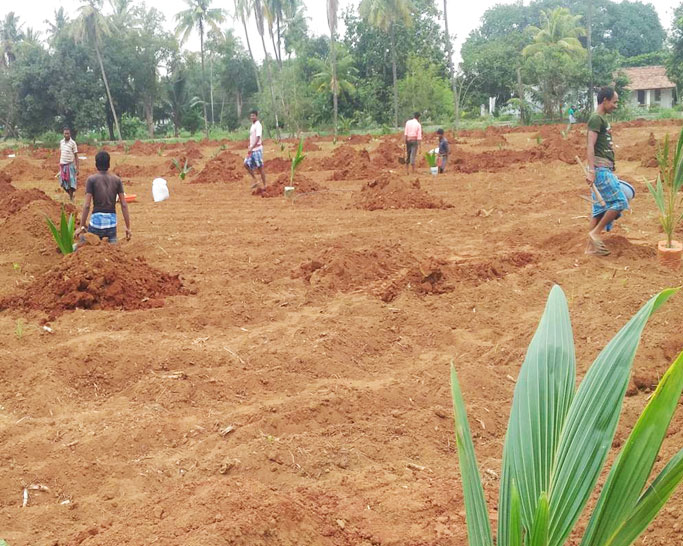
PLANTATION
Before planting the pits are filled up with top soil and powdered cow dung / compost up to a depth of 50 to 60 cm. Then take a small pit inside this, so as to accommodate the nut attached to the seedling. Plant the seedling inside this pit and fill up with soil. Press the soil well so as to avoid water stagnation. If there is chance for white-ant attack apply Sevidol 8G (5gm.) inside the small pit before planting. In laterite areas apply 2 kg common salt per pit for improving the physical condition of the soil. Burying 25 to 30 coconut husks per pit in layers will be useful for moisture conservation.

Planting Material
Coconut is propagated through seedlings raised from selected seednuts. Generally 9 to 12 month old seedlings are used for planting. Select seedlings, which have 6-8 leaves and 10-12 cm collar girth when they are 9-12 month old. Early splitting of leaves is another criteria in the selection of coconut seedling.

Planting Maintenance
After planting twice every month mix 5ml monocrotopas 36 % sl in one litter of water and spray it on leaf and centre shoot. (pest control) After planting twice every month mix 5 gm of blue copper in one litter water and spray it on the leaf and centre shoot. (fungal control)
CLIMATE AND SOIL
The coconut palm is found to grow under varying climatic and soil conditions. It is essentially a tropical plant growing mostly between 20oN 20oS latitudes. However, a rainfall of about 2000 mm per year, well distributed throughout, is ideal for proper growth and maximum production. Coconut is grown under different soil types such as loamy, laterite, coastal sandy, alluvial, clayey and reclaimed soils of the marshy low lands. The ideal soil conditions for better growth and performance of the palm are proper drainage, good water-holding capacity, presence of water table within 3m and absence of rock or any hard substratum within 2m of the surface.
TIME OF PLANTING
Seedlings can be transplanted in the beginning of the south west monsoon. If irrigation facilities are available, it is advisable to take up planting at least a month before the onset of the monsoon so that the seedlings get well established before heavy rains. Planting can also be taken up before the onset of the north-east monsoon. In low-lying areas subject to inundation during monsoon period, transplanting may be done after the cessation of the monsoon.
SITE SELECTION
Shallow soils with underlying hard rock, low lying areas subject to water stagnation and clayey soils are to be avoided. Proper supply of moisture either through well distributed rainfall or through irrigation should be ensured before planting.

PREPARATION OF LAND AND PLANTING
On slopes and in areas of undulating terrain, prepare the land by contour terracing or bunding. In low-lying areas mounds are to be formed at planting site to a height of at least 1m above water level. In reclaimed ‘kayal’ areas, seedlings are planted on field bunds. In loamy soils with low water table, a pit size of 1mx1mx1m is recommended. In laterite soils with underlying rocks, take larger pits of size 1.2m x 1.2m x 1.2m. In sandy soils the size need not exceed 0.75m x 0.75m x 0.75 m.

